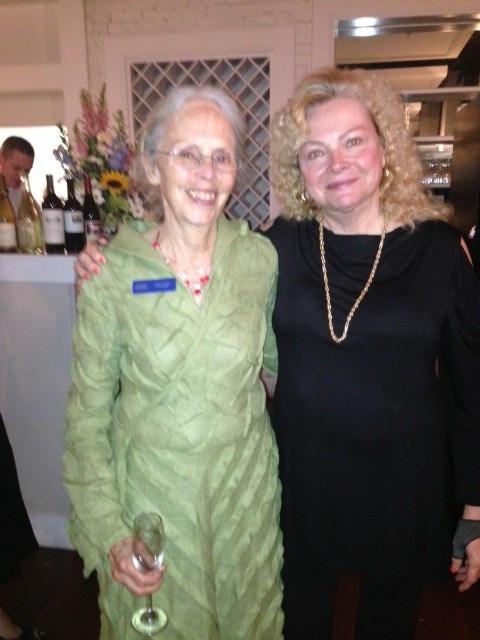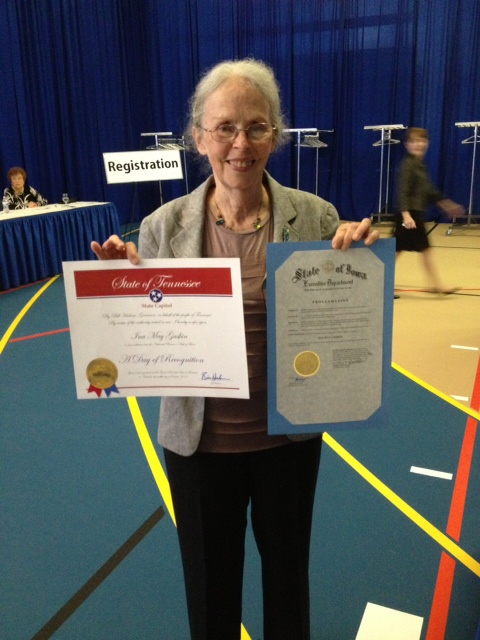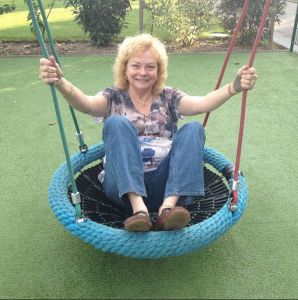
I had the honor and the pleasure to bear witness to Ina May’s induction into the National Women’s Hall of Fame in Seneca Falls, a charming small town in Upstate New York that has long been a hotbed for the women’s liberation movement—the first Convention for Women’s Rights was held there in 1848, followed by many subsequent events during our sister-ancestors’ long battle for equal rights. The National Women’s Hall of Fame is physically located there, right across the street from the Elizabeth Cady Stanton Park.
It was a grand event with hundreds of attendees. The festivities began with a Tea Party (a deliberate and not-so-subtle comment on our present political logjam!) that offered plenty of opportunities for meeting, greeting, and networking. The New York midwives turned out in force for Ina May—they planned their annual NYSALM (New York State Association of Licensed Midwives) meeting to take place in Seneca Falls so that they could all be there to support Ina May. MANA’s representative to the event, Vicki Hedley, current MANA Board member and Treasurer, kindly drove me through the gorgeous countryside on a bright sunny day that enabled us to fully appreciate the lovely vistas of mountains, valleys, and fall foliage that filled our senses with delight. I came from Texas, Juliana van Olphen Fehr (Director of the Nurse-Midwifery Program at Shenandoah University) came from Virginia, as did many others to be there for Ina May, and wow did she get a lot of cheering when she stepped forward to have that huge medal hung around her neck!

She gave a brilliant talk. She began by noting that even though she could not legally practice in New York State as a CPM, she had actually and legally attended a birth in New York, on a Native American reservation there that is not officially part of NY. “Balance” was her theme—the balance the Six Nations achieved by having men as chiefs, with a committee of women as the voters who decided what the male leaders could and could not do, such as when they could and could not go to war. She moved on to honor Mary Breckinridge, a former inductee, describing the Frontier Nursing Service that Breckenridge created, the difficult conditions under which they practiced, fording swollen streams to attend home births, and the excellent outcomes they achieved because of their courage, skills, and commitment. They achieved a remarkable sort of balance between the needs of the population and the services the FNS midwives could provide. I managed to film most of her talk on my iPhone—Debra Pascali Bonaro will be posting it on YouTube, so watch for it!
The formal induction ceremony opened with a video of Hillary Clinton welcoming us all to Seneca Falls, honoring the early feminists, and celebrating today’s induction. The other eight inductees included Betty Ford (1918-2011), Julie Krone (1963- ), Kate Millett (1934- ), Mother Mary Joseph Rogers (1882-1955), Bernice Resnick Sandler (1928- ), Anna Jacobson Schwartz (1915-2012), Emma Hart Willard (1787-1870), and Nancy Pelosi (1940- ). Betty Ford’s daughter spoke movingly of her bravery in choosing to share her diagnosis of breast cancer and her struggles with alcoholism with the world, in order to move these heretofore almost unspeakable issues into public awareness and consciousness. Julie Krone—you may not know her name, but she was one of the first female jockeys in the U.S and eventually became the leading female Thoroughbred horse racing jockey of all time. Her speech was inspirational. She described her early marginalization as a woman, being given the worst horses to ride and then learning them so well that she began to ride them to victory, over and over, against all odds, until her skills were finally fully acknowledged, at which point she began to ride back-to-back races, sometimes winning five or six races a day, and going on to become the first woman to win a Triple Crown and many other awards. Nancy Pelosi told the story of being asked to run for the House of Representatives, her concern about what that might mean for her last remaining child at home, a daughter. She told her daughter about the opportunity, said that she was willing to let that go in order to stay home and support her through her senior year of high school. Her daughter’s response: “Mom, GET A LIFE!”
The Gala Celebration after the Induction Ceremonies was a marvelous party in the Hotel Clarence in Seneca Falls—I was thrilled to be able to speak a bit with Nancy Pelosi, to shake Lilly Ledbetter’s hand and thank her for her service to women, and to observe Ina May in animated conversation with so very many people who seemed to really understand the depth and breadth of her contributions to women, midwives, and birth. I found a moment to ask Ina May, my friend of over 20 years, if she had kept a careful record on her CV of all her talks and all her publications—she said, regretfully, that she had not. I urged her to create that record so that it will not be lost! Is anybody out there up for writing the full biography that she so richly deserves?
The following day, Sunday, Vicki and I attended a lovely brunch held in Ina May’s honor by NYSALM. Invited to the mike, Ina May began with a question: “If I were younger and wanted to come and practice in New York State, what would I have to do to do so legally and how much would it cost?” She is a CPM and has a Master’s in English—the Master’s degree is now a requirement for any midwife who wants to become licensed in New York. So the answer, given most clearly by Kate Finn CPM, CM, was two years at either program for CMs—the one at SUNY downstate in NY or the one in Philly, at a cost of $50,00 to $60,000. A young aspiring midwife, already a CPM, stood up to speak of the hoops she had jumped through to become eligible for the CM SUNY downstate program, taking all the necessary prerequisite courses, only to find her application rejected. And she asked, “Why is it so hard to become a Licensed Midwife in New York, when I am already a midwife?” A fascinating discussion ensued that indicated clearly that the members of NYSALM are very open to considering alternate routes, including looking at ways to legitimate CPMs in NY. It came up in the discussion that the ICM (International Confederation of Midwives) global standards for midwifery education might be used—yet CNMs and CMs in New York operate far beyond those standards because they are trained not only in maternity care but also in lifetime well-woman care. And, as some of them said, they simply love not having to say goodbye to their clients after birth because they can offer them ongoing, lifetime care. Yet no one there seemed to want “tiered midwifery”—meaning that there would be various hierarchical classifications of midwives (as there are for nurses)—so the dilemma of how to incorporate the CPM in New York remains. They are going to work on that!
After the brunch, Vicki and I found time to visit the National Women’s Hall of Fame. It was incredibly inspiring to find so many of my personal culture heroes honored there. Too many to mention here, but I will just say that in a glass display case, there was a scarf that had belonged to Amelia Earhart (a posthumous inductee). Sally Ride, another inductee, had taken that scarf into outer space as a tribute to her personal culture hero Amelia, and then had returned it to the museum. Women honoring women. I was moved beyond words to hear that story, to see Sally’s uniform also displayed there, and to move around the museum gasping at the stories on the plaques of the women honored there, with tears flowing as I honored their individual and collective achievements. And walking into that Hall of Fame, the first thing I saw was Ina May’s plaque complete with photo right next to Betty Ford’s, on the display panels in the middle of the room of the new inductees.
We have a lot further to go, but we have come a very, very long way in our collective efforts to guarantee equal rights for women, and now for the next cause—human rights in childbirth—a cause that our marvelous Ina May has long championed. She has been a spearhead for that movement in many countries around the world. Let’s pause a moment to celebrate her recognition as a champion of normal birth and women’s rights, then take a deep breath and go on to do the work of making physiologic birth and respectful treatment of laboring mothers the global norm! So many brave women have paved the way—let us follow in their footsteps and make new paths of our own.
 Robbie E. Davis-Floyd, Ph.D. is an International Speaker, Accomplished Author, Medical/Cultural Anthropologist, Expert on Childbirth and Midwifery, Editor and Reviewer, and Consultant and Senior Research Fellow, Dept. of Anthropology, University of Texas Austin.
Robbie E. Davis-Floyd, Ph.D. is an International Speaker, Accomplished Author, Medical/Cultural Anthropologist, Expert on Childbirth and Midwifery, Editor and Reviewer, and Consultant and Senior Research Fellow, Dept. of Anthropology, University of Texas Austin.
Ina May has shone the spotlight for me because…
…she is kind and humble and funny (not strident and angry) when she refutes “established cultural norms”
…she wrote her first book in a way that made the reader follow her further into natural birth than most of her readers were probably willing to go when they first picked up the book
…she is frankly sexual, but not sexualized, in the way she talks, dresses, and acts. I see her as a sexual actor, not a sexual object.
…she loves birth and being around her in person or through her books or videos, that ENJOYMENT is contagious.
Thanks Ina May (and Robbie Davis-Floyd and Debra Pascali Bonaro, too!)